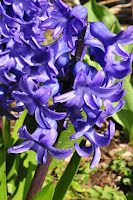Apparently, like icons, pysanky are written, not drawn. There is lots
of symbolism in the designs. The first found wax resist dyed egg dates from
about the 15th century. There are decorated eggs found from the
neolithic era, although they are made of ceramic. There is an ancient
history for decorated eggs, that is for sure.
2 kistka and a beeswax disk used to draw the wax lines on the eggs. The small, pointed tip of the kistka is heated in a candle flame, then dipped in the wax, which melts and fills the reservoir, allowing lines to be drawn on the egg shell, like a pen. Lightly drawn pencil lines can be used as guidelines, especially useful for long, straight lines. The beeswax turns black when the candle soot mixes in. This makes the wax easier to see on the egg, but doesn't affect the outcome.

All the areas which you want to be white are covered with wax first. The the egg is dipped into the first colour. Once the egg is dyed to the desired depth of colour, it is removed from the dye and allowed to dry. Then the areas which you want to be the next colour are covered with wax. Here the orange egg has been dyed twice, with the white, yellow and orange areas covered with wax. The dyes need to be applied in a particular order. Green can contaminate other colours so is often painted in areas specifically and then covered, rather than dipping the whole egg in the dye. Blue and green are usually dyed before red, but the blue will make the red turn a bit purple, so it is useful to plan out the colours ahead of time. Brown eggs may not show all the colours clearly and the colours won't be as bright s on white eggs.
.

The orange egg has been dyed red, but of course I took the photo before the red areas were covered. The yellow egg took quite a while to cover all those triangles. It took several hours in 2 different sessions. You would think that the black sooty wax would show the areas missed when trying to completely cover an area, but it doesn't really.
To remove the wax after all the dyeing is complete, the egg is held near the flame and the wax is wiped off as it melts. You can only do a small area at a time as the wax cools down fairly quickly. I'm a little disappointed in the yellow dye. It has weakened fairly quickly and it doesn't dye the eggs evenly. I don't know if that is an issue with the eggs or the dye. Because of the weakness of the yellow dye, the contrast on the yellow and white triangles isn't quite enough to be really effective. On the other hand, the purple egg, which is a replacement for the one I found cracked, is much nicer than the one that I originally made.
I've 6 finished, although I really made 8, but 2 had cracks in them. I might have time to make 1 or 2 more before I need them to fill the Easter Basket.

























